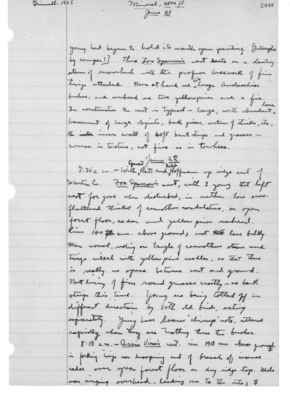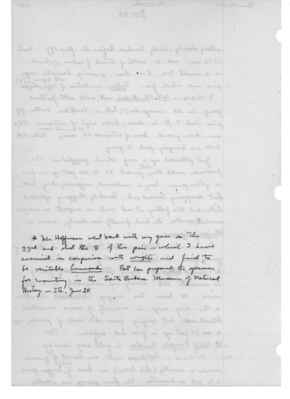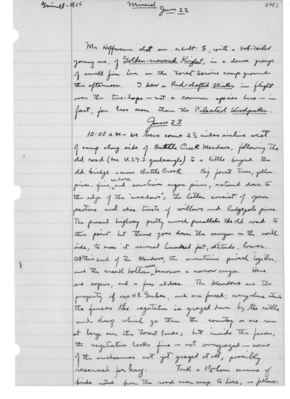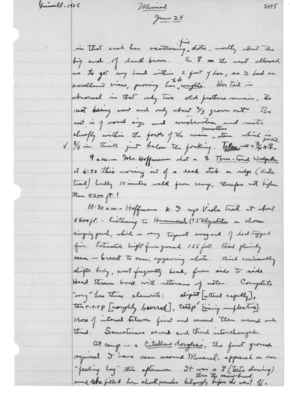Pages That Mention Hoffmann
1925: Joseph Grinnell's field notes
S2 Page 33
Collector: Grinnell-1925 Location: Mineral, 4800 ft. Date: June 21 Page Number: 2488
young had begun to hold its mouth open pouting. [Interrupted by camper!] This Fox Sparrow's nest rests on a slanting stem of snow-bush with the proper lacework of fine twigs attached. Near at hand are two large Amelanchier bushes; and overhead are two yellow pines and a fir. In construction the nest is typical - large, with abundant loose basement of large objects, bark pieces, section of sticks, etc., the inner wall of soft bark strips and grasses course in texture, not fine as in towhees.
June 22 7:34 a.m. - With ^Egmont Rett and ^Ralph Hoffmann up ridge east of Martin Cr. Fox Sparrow's nest, with 3 young that left nest for good when disturbed, in rather low snow flattened thicket of ceanothus cordulatus, on open forest floor, cedar and yellow pines overhead. Rim 140 ft mm. above ground; nest last less bulky than usual, resting on tangle of ceanothus stems and twigs mixed with yellow pine needles, so that there is really no open space between nest and ground. Nest lining of fine round grasses mostly - no bark strips this time. Young are being lolled (?) off in different direction by both old birds, acting separately. Young have hoarse "chirrup" note, uttered rapidly when they are trotting thru the bushes.
8:15 a.m. - Cassin Vireo's nest: rim 1910 mm. above ground in forking twigs near drooping end of branch of incense cedar over open forest floor on dry ridge top. Male was singing overhead, leading me to the site; [female symbol]
S2 Page 35
Collector: Grinnell - 1925 Location: Unspecified (but presumably either proximate to Mineral or having left for elsewhere). Date: June 24 Page Number: No formal page #.
* Mr. Hoffmann went back with my gun on the 23nd and shot the male of this pair - which I have examined in comparison with wrighti and find to be veritable hammondi. Rett has prepared the specimen for mounting in the Santa Barbara Museum of Natural History - J. G., June 24.
S2 Page 36
Collector: Grinnell - 1925 Location: Mineral Date: June 22 Page Number: 2490
sheltered within the cavity, the nest being in-set in bark and needle floor right against the charcoal wall. Rim of nest (exposed side) marked by coarse pine twigs and needles, scattering out towards opening of cavity; latter 600 mm. high at peak, 480 mm. wide at base of opening; rim of nest a little higher, about 25 mm., than ground in front. Nest found by watching old birds, with food perching around quietly on stubs of fallen logs and lower branches of big standing trees, finally flying down to side. The yellow thickened corners of mouth and edges of bill loom up a most conspicuous feature of young in shade of cavity. On dry ridge top, open forest of white fir, cedar, yellow and sugar pines.
Saw a Sharp-shinned Hawk in flight from direction of camp, well above tree-tops. One or both of a pair of Evening Grosbeaks were noted repeatedly in a certain section of the woods. Mr. Hoffmann discovered a Hammond(*) Flycatcher's nest^(5500 ft. alt.) fully 90 ft. up on a horizontal sub-branch of a huge sugar pine - of course inaccessible. The birds looked ^at that range and sounded, to me, indistinguishable from the "Wright" Flycatchers I have been getting down here with low brush-built nests. However, only shooting of the birds can settle their identity. I saw one of Hoffman's birds come clear to the ground and flit about in small firs and low snow-brush; yet both of the birds did a lot of foraging fully 100 feet up, in firs and pines.
S2 Page 38
Collector: Grinnell - 1925 Location: Mineral Date: June 22 Page Number: 2492
Mr. Hoffmann shot an adult male, with a bob-tailed young one, of Golden-crowned Kinglet, in a dense group of small fir here on the Forest Service camp ground this afternoon. I saw a Red-shafted Flicker in flight over the tree-tops - not a common species here - in fact, far less seen than the Pileated Woodpecker.
June 23 10:00 a.m. - we have come 2 1/2 miles airline west of camp along side of Battle Creek Meadows, following the old road (see U.S.G.S quadrangle) to a little beyond the old bridge across Battle Creek. Big forest trees, yellow pines, fir, cedars, and sometimes sugar pines, extend down to the edge of the "meadows"; the latter consist of open pasture and also tracts of willows and lodgepole pines. The present highway pretty much parallels the old road to this point but thence goes down the canyon on the north side, to cross it several hundred feet, altitude, lower. At this end of the Meadows, the mountains pinch together, and the creek bottom ^soon becomes a narrow canyon. Here are aspens, and a few alders. The Meadows are the property of one W. L. Gerber (?), and are fenced; everywhere astride the fences the vegetation is grazed down by the cattle and sheep which go thru [sic] the country or are seen at large over the forest lands; but inside the fences, the vegetation looks fine - not overgrazed - some of the enclosures not yet grazed at all, possibly reserved for hay. Took a 1 1/2 hour census of birds notes from the road near camp to here, as follows:
S2 Page 41
Collector: Grinnell - 1925 Location: Mineral Date: June 24 Page Number: 2495
in that each has scattering ^fine dots, mostly about the big end, of dark brown. The [female symbol] on the nest allowed me to get my hand within 2 feet of her, as I had an excellent view, proving her ^to be wrighti. Her tail is abnormal in that only two old feathers remain, the nest being new and only about 2/3 grown out. The nest is usual size and construction and nests chiefly within the forks of the main ceanothus stem which is 5/8 in. thick just below the forking. Taken nest + 3/4 + [female symbol] ^parent. 9 a.m.-- Mr. Hoffmann shot a (female) Three-Toed Woodpecker at 6:20 this morning out of a dead stub on ridge (Viola trail) hardly 10 minutes walk from camp, therefore not higher than 5200 ft.! 10:30 a.m. Hoffmann and I up Viola Trail at about 5500 ft. listening to Hammond (?) [sic] Flycatcher on chosen singing perch, which is very topmost snag-end of dead-topped fir. Estimated height from ground 135 feet. Bird plainly seen - breast to sun, appearing white. Bird continually shifts body, most frequently head, from side to side. Head thrown back with utterance of notes. Complete "song" has three elements: se-'put [uttered rapidly], taur-r-rp [roughly burred], tseep´ [rising inflection]. More of interval between first and second than second and third. Sometimes second and third interchanged. At camp - a Citellus douglasi, the first ground squirrel I have seen around Mineral, appeared on our "feeding log" this afternoon. It was a [female symbol] (teets showing) and she filled her cheek pouches bulgingly before she went off ^thru [sic] the snow-bush.




